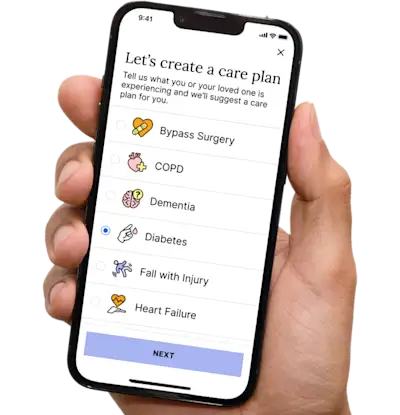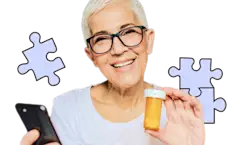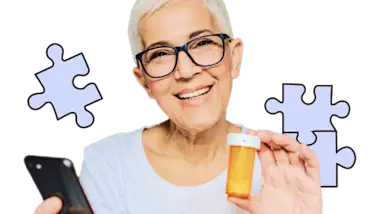Caregiving Challenges, What are ADLs and IADLs?
You hear the terms "ADL" and "IADL" among healthcare professionals, but what do they mean and are they relevant to you and your loved one?
Get insurance benefits, legal documents, and medical records in one place

Helpful Highlights
You've probably heard the term "ADL", but what does it mean and how does it differ from a term you may not have heard - "IADL"?
The definitions and differences are important to understand for many reasons including care delivery, provider assessment, facility placement, and insurance purposes.
As your loved one ages in place, you may be asked by healthcare professionals whether your loved one needs any help with ADLs or IADLs. You'll want to understand what these mean and know how to answer.
ADLs and IADLs represent key life tasks that people need to be able to manage in order to live at home and be independent. While ADLs are basic self-care tasks, IADLs require complex planning and thinking. As a caregiver, it is good to familiarize yourself with these terms and the related skills.
ADLs = Activities of Daily Living
ADLs, or activities of daily living, are more basic tasks that are essential to independent living and are related to personal care.
Bathing or showering - use of a tub or shower chair and grab bars is acceptable.
Dressing and undressing - use of grabbers or other assistive devices is acceptable.
Grooming - attending to their personal appearance (face, hair, nails).
Transferring - being able to move from one surface to another. Bed to a chair, chair to wheelchair, bed or chair to a walker or other assistive device.
Ambulation (walking) - the use of assistive devices is acceptable.
Toileting - getting on and off the toilet, using it appropriately, cleaning oneself, and managing any incontinence products. The use of grab bars is acceptable.
Eating (feeding self) - can handle utensils and move foods and liquids to their mouth without assistance.
For each ADL, people can vary from needing no help, to needing a little help, to full dependency. Full dependency requires others to do the task for them.
IADLs = Instrumental Activities of Daily Living
IADLs, or instrumental activities of daily living, are more complex tasks, greatly associated with household management, that require thinking and planning, and are still largely necessary for everyday life.
Managing finances - paying bills and managing financial assets (bank accounts, credit cards, investments, properties).
Managing transportation - either driving themselves or being able to organize other means of transportation when needed.
Shopping and meal preparation - everything required to get a meal on the table, as well as shopping for clothing and household items required for daily life.
Housekeeping and maintenance - cleaning and repairs around the home.
Managing communication - being able to use the telephone and handle the mail appropriately.
Managing medications - obtaining medications and taking them on time, as directed.
The amount of assistance required with ADLs and IADLs correlates to how much direct help, monitoring, and hands-on care is needed in the home, and can determine if someone is safe to live independently.
Why ADLs and IADLs matter
Generally, older adults need to be able to manage ADLs and IADLs in order to live independently without the assistance of another person. Deficits in ADLs and IADLs indicate problems with physical and/or brain health. The goal is to make sure older adults are getting the help and support they need to overcome difficulties in performing ADLs or IADLs and continue successfully and safely living on their own.
Improving ADL performance is the focus of rehabilitation programs and home health care. Therapists work on strength, balance, functional, and mobility issues. Nurses work on all aspects of chronic disease management.
ADLs are the most common triggers used by insurance companies to determine eligibility for long-term care insurance benefits.
No content in this app, regardless of date, should ever be used as a substitute for direct medical advice from your doctor or other qualified clinician.
Get more support and guidance on insurance benefits, medical records and legal forms.
Helpful brings together your insurance benefits, legal documents, and medical records in one personalized place — so you always know what you have, and never have to search again.

Technology for Health Tasks. Mental Health for the Tough Stuff.
Helpful connects your medical records, insurance, and caregiving tasks automatically. And when you need more than logistics, a therapist is here to guide you.
In-Network and Covered
For Individuals, Couples and Families
HIPAA Compliant, Data Stays Private


Healthcare Tasks Simplified

From syncing records to spotting drug interactions, Helpful does the heavy lifting, turning complex health info into clear tasks and showing you benefits you can actually use, giving you clarity and control over your care.

In-Network Mental Health

Our licensed therapists are here to support you and your loved ones through stress, burnout, and life’s hardest moments, with an inclusive, compassionate approach that works with most insurance plans.

Create Legal Documents

Plan ahead by creating will, trusts, advance directives and more, that ensure your wishes are honored in the event you can’t speak for yourself -with Helpful guiding you every step of the way.